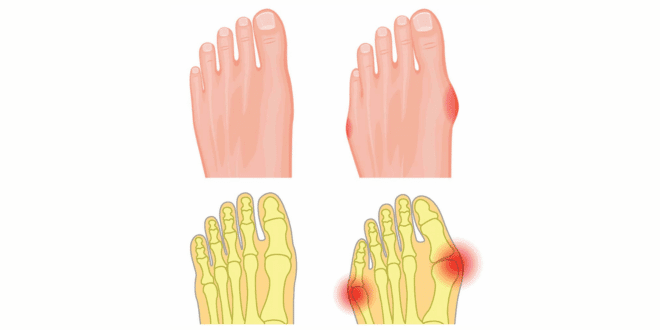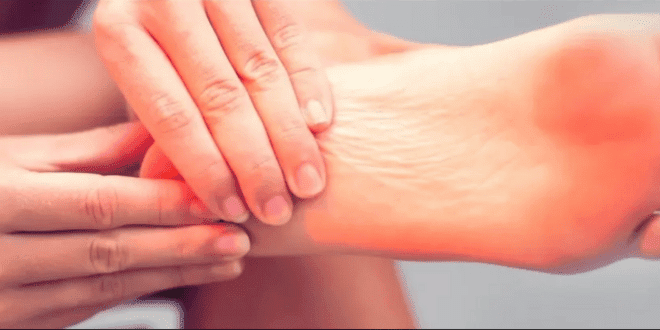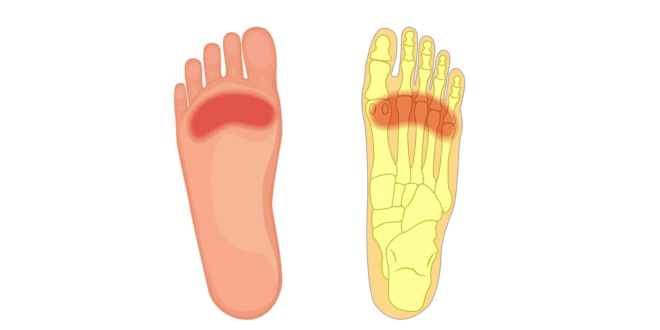Foot Condition

Podiatric Conditions:
⦁ Hallux Valgus:
Definition:
Hallux valgus, also referred to as a bunion, is a prevalent foot abnormality characterized by the inward rotation of the main joint of the big toe, resulting in the development of a bony protrusion on the inner side of the big toe joint. This condition is commonly caused by prolonged pressure on the big toe joint, pushing it out of alignment.
Causes:
Hallux valgus can arise from foot mechanics and structure, as well as genetic factors. Unfavorable walking patterns or abnormal foot shapes can exert pressure that causes the base of the big toe to turn inward towards the adjacent toe. While wearing tight, narrow shoes can exacerbate the pain, they are typically not the root cause.
Symptoms:
The primary symptom of hallux valgus is pain at the bony protrusion formed at the base of the big toe joint. The joint may become stiff, and inflammation can cause the area to ache and feel warm. Changes in toe alignment can also lead to radiating foot pain. Other potential symptoms include a lowered transverse arch and widening of the front part of the foot.
Treatment:
⦁ Rest and avoid activities that worsen the pain. Allow your foot to heal by refraining from high-impact exercises and reducing time spent on your feet.
⦁ Apply ice to the affected area to reduce inflammation and alleviate pain. Repeat this process several times a day, with each session lasting 15-20 minutes.
⦁ Wear comfortable and supportive shoes that offer adequate arch support and cushioning. Steer clear of high heels, flip flops, and shoes lacking proper arch support.
⦁ Engage in stretching exercises that target the plantar fascia, Achilles tendon, and calf muscles to alleviate pain and support healing. Consult a physical therapist or podiatrist for personalized stretching routines.
⦁ Consider using custom insoles designed to provide additional arch support and cushioning. These insoles should be tailored to fit your feet for optimal comfort and support.


Plantar Fasciitis
Definition:
Plantar fasciitis is a prevalent condition characterized by pain in the heel and arch of the foot. It occurs when the plantar fascia, a fibrous tissue band that supports the foot’s arch, becomes inflamed.
Causes:
There are various factors that contribute to the development of plantar fasciitis, including footwear, foot structure, excess weight, and excessive strain or pressure on a hard surface. Additionally, a forceful impact or landing on the foot from a height can also lead to inflammation of the heel’s membrane.
Symptoms:
The primary symptom of plantar fasciitis is pain on the sole of the foot, specifically along the inner edge of the heel. The pain is typically more intense when starting to move, such as in the morning, and may decrease throughout the day or with activity. Walking barefoot or wearing unsupportive shoes can exacerbate the pain.
Treatment:
⦁ Rest and avoid activities that worsen the pain. Allow your foot to heal by avoiding high-impact exercises and reducing the amount of time spent on your feet.
⦁ Apply ice to the affected area to reduce inflammation and alleviate pain. Repeat this process several times a day, with each session lasting 15-20 minutes.
⦁ Wear comfortable and supportive shoes that offer adequate arch support and cushioning. Avoid high heels, flip flops, and shoes with poor arch support.
⦁ Engage in stretching exercises that target the plantar fascia, Achilles tendon, and calf muscles to alleviate pain and promote healing. Consult a physical therapist or podiatrist for personalized stretching routines.
⦁ Consider using custom insoles designed to provide additional arch support and cushioning. These insoles should be tailored to fit your feet for optimal comfort and support.
⦁ Morton’s Neuroma
Morton’s neuroma involves the thickening or swelling of the tissue around the nerve between the bases of the toes, typically between the third and fourth toes. This condition is often a response to irritation, pressure, fallen transverse arch, or nerve injury. Symptoms may include a sensation of standing on a pebble in the shoe, burning pain in the ball of the foot that may radiate into the toes, and tingling or numbness in the toes.
⦁ Metatarsalgia
Metatarsalgia is characterized by pain in the front part of the foot, specifically under the metatarsal heads, which are beneath the base of the toes. It is typically caused by increased pressure on the ball of the foot, often due to ill-fitting footwear or irritation/injury of the metatarsal heads or surrounding soft tissues. Symptoms include a feeling of walking on pebbles, burning or aching sensation, shooting pain, or tingling/numbness in the toes. Shin Splints Shin splints refer to pain felt along the inner frontal edge of the shin bone. It is usually caused by repetitive trauma or strain injury to the connective muscle tissue surrounding the tibia. Shin splints commonly occur in runners and athletes due to the repetitive stress placed on the shinbone and associated connective tissues. Symptoms include tenderness, soreness, or pain along the inner side of the shinbone, and in severe cases, swelling in the lower leg may occur.


Morton's Neuroma
This condition involves the thickening of tissue encompassing one of the nerves leading towards the toes, provoking a sharp, fiery discomfort in the foot’s ball.
This condition involves the thickening of tissue encompassing one of the nerves leading towards the toes, provoking a sharp, fiery discomfort in the foot’s ball.
Concurrently, a prickling, burning sensation or even numbness could manifest in the toes. The use of high-heeled shoes or constricting footwear has been correlated with Morton’s neuroma. For many, transitioning to lower-heeled shoes with broader toe compartments provides relief. In certain instances, corticosteroid injections or surgical intervention might be warranted.
Symptoms
Usually, outward indications such as a lump aren’t evident. Rather, the following symptoms are common:
Sensation of walking on a pebble within the shoe
Burning pain localized in the foot’s ball, which might extend to the toes
Tingling or loss of sensation in the toes
Additionally, many individuals discover that removing their footwear and gently massaging the foot can alleviate the discomfort.
Causes
Morton’s neuroma appears to develop in response to nerve irritation, pressure, or injury that involves the pathways leading to the toes.
Risk Factors
Several factors contribute to the likelihood of Morton’s neuroma, including:
Footwear Choice: The usage of high-heeled shoes or tight, ill-fitting footwear exerts undue pressure on the toes and forefoot.
Specific Sports Participation: Engaging in high-impact sports activities such as jogging or running exposes the feet to repetitive trauma. Activities that entail snug footwear, such as snow skiing or rock climbing, can exert compression on the toes.
Foot Structural Anomalies: Individuals with foot irregularities like bunions, hammertoes, unusually high arches, or flat feet possess an elevated risk of developing Morton’s neuroma.


Metatarsalgia
Symptoms of Metatarsalgia
Metatarsalgia manifests primarily as discomfort situated at the terminus of one or more metatarsal bones, which are positioned in the forepart of the foot near the toes. The pain may exhibit itself as a sharp sensation, a persistent dull ache, or even a sensation akin to burning.
Indications of Metatarsalgia
Excessive pressure concentrated on a specific area of the foot precipitates the pain associated with metatarsalgia.
This often occurs due to the stresses endured during high-impact sports. Alternatively, abnormalities in bone or muscle structure that lead to an uneven distribution of pressure across the feet might also be causative factors. Such abnormalities could encompass a shorter first metatarsal bone, an elongated second metatarsal bone, prominent metatarsal heads, tight toe extensor muscles, weakened toe flexor muscles, hammertoe deformity, hypermobile first foot bone, or a tight Achilles tendon. Additionally, factors such as excessive pronation, ill-fitting footwear, overweight status, stress fractures in the metatarsals or toes, bunions, torn ligaments in the feet, and Morton’s neuroma—a condition involving excess tissue around a nerve—can contribute to the emergence of metatarsalgia-like symptoms, including pain and numbness.
Risk Factors for Metatarsalgia
Athletes engaging in high-impact sports in the United States often encounter forefoot injuries, among which metatarsalgia is common. Activities involving running and jumping are primary culprits, particularly affecting track and field runners, but also extending to athletes in tennis, football, baseball, and soccer. Predisposing factors to metatarsal discomfort include having a high arch, wearing high-heeled shoes, suffering from joint inflammation-related disorders like osteoarthritis, rheumatoid arthritis, or gout, and the natural thinning of the fat pad cushioning the forefoot as age progresses.
Diagnosis of Metatarsalgia
Diagnostic processes for metatarsalgia might involve X-rays to exclude other causes of forefoot pain, bone scans to locate areas of inflammation, ultrasound to identify conditions like bursitis or Morton’s neuroma, and MRI scans to explore traumatic disorders, circulatory issues, arthritis, neuroarthropathies, and biomechanical imbalances contributing to metatarsal and midfoot discomfort.
Managing Metatarsalgia
Management strategies for metatarsalgia encompass several approaches:
Medical Interventions:
⦁ Rest and avoidance of high-impact activities.
⦁ Application of ice and pressure bandaging.
⦁ Utilization of cushioned pads, arch supports, or orthotics within footwear.
⦁ Incorporation of gentle stretching and strengthening exercises.
⦁ Potential scraping of calluses contributing to pain.
⦁ Surgical intervention in cases of bone issues or pinched nerves.
Medication:
Short-term pain relief through nonsteroidal anti-inflammatory drugs (NSAIDs) like ibuprofen or naproxen.
Nerve blocks coupled with long-acting steroids for pinched nerve-induced pain.
Recovery and Prevention
Following pain resolution, gradual reintegration of stretching, strengthening exercises, and low-impact activities like swimming can aid recovery.
Preventive measures include:
⦁ Ensuring well-fitting footwear, especially for regular runners.
⦁ Abstaining from high-heeled shoes.
⦁ Adhering to recommended pads, arch supports, or orthotics.
⦁ Preventing callus buildup through gentle foot care.
⦁ Maintaining a healthy weight.
⦁ Incrementally increasing athletic activity.
⦁ Incorporating stretching and warm-up routines before exercise.
⦁ Prognosis and Avoidance of Recurrence
⦁ Most individuals recover from metatarsalgia with appropriate treatment. To prevent recurrence, understanding the underlying cause and implementing preventive measures is crucial.


